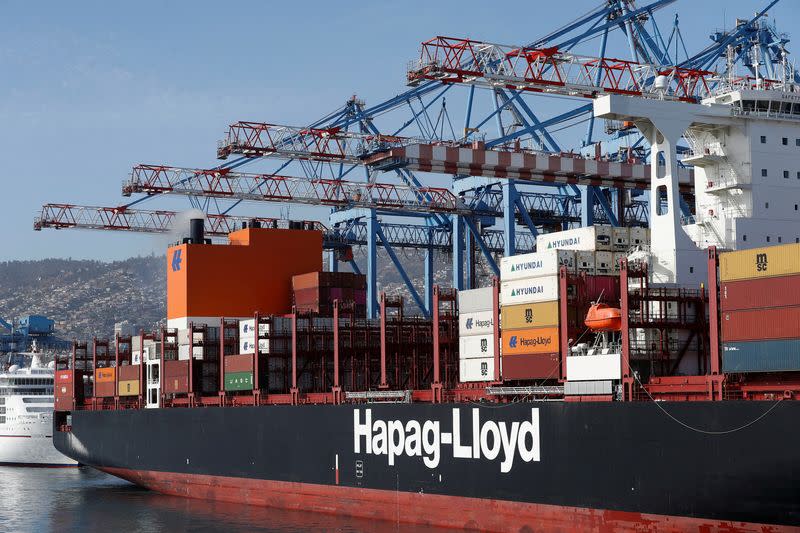The head of one of the world’s biggest shipping lines said attacks on cargo vessels in the Red Sea are unlikely to end soon, so vessels are likely to avoid travelling through the Suez Canal.
Rolf Habben Jansen, CEO of Germany’s Hapag-Lloyd, the world’s fifth biggest container line, told reporters in Hamburg on Wednesday: “We don’t think it will be over the day after tomorrow. [But] whether it’ll be one, three or five months – I don’t know.”
A political deal and a mission to protect freight vessels might bring a resolution within six months, he added.
ALSO SEE: Oil Producers, Carmakers Knew of Climate Risk in 1954 – Guardian
Hapag-Lloyd has joined other shippers in taking longer, costlier journeys around Africa, after one of its ships was attacked on December 15.
It was important that the European Union actively supports a multinational naval coalition to protect commercial traffic in the region, Habben Jansen said.
EU to send naval mission by Feb 17
The EU said on Wednesday it plans to assemble a group of warships and planes to complement one already formed by the US and other allies within the next three weeks to help defend cargo ships against attacks by Houthi rebels in Yemen that have caused supply chain costs to soar.
EU foreign policy chief Josep Borrell said he wants the naval mission to be in the Red Sea region by February 17, but he stressed that they would only be protecting ships – “not participating in any kinds of actions against the Houthis. Only blocking the attacks of the Houthis.”
US and British vessels and planes have bombed targets in a range of locations in Yemen in recent weeks, but Borrell said that the EU mission would not do that. Belgium, Germany and five other EU nations are reportedly ready to provide ships or planes.
Jansen, meanwhile, said that rerouting around Africa makes cargo voyages two to three weeks longer and that had caused a drop of 150,000 standard containers (TEU) being transported in December compared with original expectation, he said.
Hapag-Lloyd transports roughly one million TEU per month on its 264-strong fleet.
Mitigations have included buying more containers, adding 125,000 in TEU capacity at a cost of $350 million, it said. But using more ships to meet demand on time, and running those faster on more fuel, involved higher costs for customers.
On Tuesday, Hapag-Lloyd reported earnings before interest and tax for 2023 of 2.5 billion euros ($2.7 billion), a fraction of 2022’s 17.5 billion euros. It cited lower freight rates as global supply chains normalised following the pandemic.
Energy traders, shippers grapple with fallout
In one example of the impact, the supertanker Grand Bonanza set out early this month on a roughly 40-day journey carrying 1.8 million barrels of Abu Dhabi crude for TotalEnergies from the United Arab Emirates all the way around Africa to France.
The trip will take at least two weeks longer than the normal route via the Suez Canal, and at about $5.7 million, will cost nearly 80% more, according to estimates by a shipping source and data from LSEG and Kpler.
A strike last Friday on a Trafigura-chartered fuel tanker underscored the risk.
Energy producers and traders are weighing the higher prices of longer voyages around the Cape of Good Hope and using larger crude tankers to manage costs and risks, while buyers are demanding discounts to compensate for higher freight and war risk premiums.
Shippers are revising routes and refuelling points and accelerating cruising speeds, which burns more fuel and increases emissions.
European refiners are hurt by the increased shipping times that are driving up costs for their crude, but their margins are supported by a drop in competing product imports from the Middle East and India, traders said.
US refiners benefit as they can send fuel products to Europe to replace supply from the Middle East, said Mukesh Sahdev, head of oil trading at consultancy Rystad Energy, just as the US did with natural gas, replacing Russian supply after Moscow’s invasion of Ukraine.
“The recent Red Sea attacks pose both a threat to EU refined products imports and an opportunity for the US refining system to again fill the gap,” he said.
For European refiners buying Iraq’s Basrah oil, rising import costs are dampening demand in the first quarter, traders said.
One deterrent is that VLCCs, which can carry up to 2 million barrels, are too big to dock at Russia’s Novorossiysk port where CPC Blend is exported, which means cargoes must be transferred from smaller tankers to VLCCs, incurring additional costs.
“I can see the market creating a clear east/west split. Basrah stays east, CPC stays west,” a person involved in CPC oil trading said.
Meanwhile, TotalEnergies has provisionally chartered VLCC Amphion to load crude from Fujairah to the United Kingdom on February 6-7, a shipping source said. The charter comes with the option of going via the Cape of Good Hope at about $6.4 million or via Suez at about $3.7 million.
- Reuters with additional editing by Jim Pollard
ALSO SEE:
Singapore-Bound Oil Tanker Hit as Red Sea Tensions Escalate
Red Sea Attacks Pose Billions Worth of Risks for China, India
Chinese Exporters Face Shipping Crisis From Red Sea Attacks
Shipping Chaos Set to be ‘New Normal’ Amid War, Climate Change
























